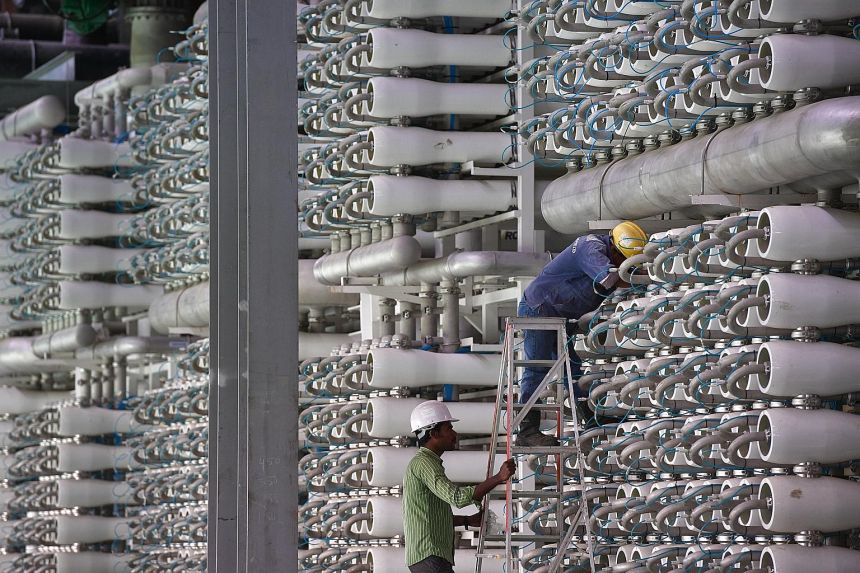ScienceTalk: Benefits to be reaped if we don't let wastewater go to waste
Sign up now: Get ST's newsletters delivered to your inbox

Workers inspecting the reverse osmosis trains at a Newater plant in Changi.
PHOTO: ST FILE
Anika Cokro for The Straits Times
Follow topic:
Having worked with wastewater and sewage sludge for seven years, I have developed not only a selective loss of smell (anosmia), but also true respect for wastewater.
Just look at the coronavirus pandemic and we can appreciate how wastewater has become a surveillance tool to detect possible Covid-19 infections.
Scientists at Nanyang Technological University (NTU) and the National University of Singapore (NUS) routinely test wastewater at the student hostels on campus as a precautionary measure to screen for circulation of the virus in the population.
And there is a lot more to wastewater than that.
Wastewater recycling is crucial because there is water scarcity in different parts of the world, even in an economically and technologically advanced country such as Singapore.
This is, after all, one of the most water-stressed countries in the world. For Singapore, as a tiny city state with a limited water catchment area and no other natural water resources, every drop counts - even wastewater.
Wastewater recycling has undeniably become the norm instead of the exception in many countries, including Singapore.
The Republic consumes about 1.9 million cubic m of water a day, with the non-domestic sector accounting for more than half of this demand.
Research to upcycle and return wastewater constituents to the circular economy is key to ensuring the sustainable use of water, more so on the industrial front.
For wastewater to be reused, it has to undergo strict treatment to meet all the regulations, and this is a complex and costly process.
Wastewater treatment processes also produce sludge that needs to be treated before it can be safely discharged to a landfill or incinerated (typically, the ash generated from the incineration will end up in a landfill too).
A common sludge treatment method is anaerobic digestion (AD) - a biological process that not only treats the sludge by removing the undesirable organics in it, but also reduces the volume of sludge that needs to be discarded or incinerated.
This is aligned with the Singapore Green Plan 2030, which aims to reduce waste sent to the landfill by 30 per cent, with a target of 20 per cent reduction by 2026.
Microbiome to the rescue
Research to improve the efficiencies of wastewater treatment has been rigorously conducted in Singapore and beyond.
Since wastewater treatment typically involves biologically driven processes collectively called "digestion", a good understanding of the microbiome - microorganisms that exist in a particular environment - that drives this process is needed.
For example, a study at SCELSE, a biofilm and microbiome research centre hosted by NTU and NUS,
assesses the ability of the AD microbiome to function at a shortened digestion time of five days instead of 30 - six times faster - to speed up the digestion process for greater efficiency.
This microbiome is sensitive to changes in its environment. So, the scientists are also looking to improve its ability to withstand disturbances in order to minimise downtime and failure of the digesters (huge vessels where biological reactions take place), which can be costly to rectify.
Upcycling
We can also upcycle wastewater.
This fashionable term refers to the creation of something new out of waste or old materials.
I used to associate wastewater with "destroying" and "removing" instead of "creating" or "generating". But research has opened my eyes to the potential of wastewater to generate valuable products.
For example, AD converts sludge and other biowaste to clean gaseous methane, which can be used by other microorganisms to produce safe protein-rich microbial biomass as a source of animal feed or food.
Although there is still some way to go, such renewable energy sources can be used instead of conventional fossil fuel, and thus support the Singapore Green Plan.
Sludge can also be used to produce other value-added products, such as volatile fatty acids (VFAs).
VFAs can be turned into biopolymers like polyhydroxyalcanoates - plastics that are more biodegradable than their petrochemically derived counterparts.
Upcycling is taken to a whole new plane too when we produce single-cell protein from wastewater that food and beverage industries would have discarded.
These microbial proteins can then be used to produce fish food.
So, with all these potential gains, we stand to benefit if we do not dismiss wastewater.
But all this boils down to our ability to conserve water, since wastewater can be generated only if there is clean water to begin with.
So, start appreciating every drop and plop that comes your way.
Dr Anika Cokro is a research fellow at SCELSE, a research centre for biofilm and microbiome, hosted by NTU and NUS.

